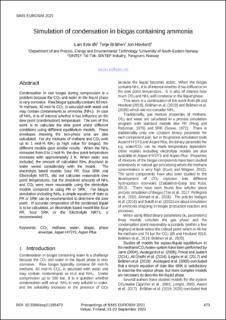Simulation of Condensation in Biogas containing Ammonia
Peer reviewed, Journal article
Published version
Permanent lenke
https://hdl.handle.net/11250/3076558Utgivelsesdato
2021Metadata
Vis full innførselSamlinger
- Publikasjoner fra CRIStin - SINTEF AS [5801]
- SINTEF Industri [1565]
Originalversjon
Linköping Electronic Conference Proceedings. 2021, 185, 473-480. 10.3384/ecp21185473Sammendrag
Condensation in raw biogas during compression is a problem because the CO2 and water in the liquid phase is very corrosive. Raw biogas typically contains 60 mol-% methane, 40 mol-% CO2, is saturated with water and may contain contaminants as ammonia (NH3). In case of NH3, it is of interest whether it has influence on the dew point (condensation) temperature. The aim of this work is to calculate the dew point under different conditions using different equilibrium models. Phase envelopes showing the two-phase area are also calculated. For dry mixtures of methane and CO2 with up to 1 mol-% NH3 (a high value for biogas), the different models gave similar results. When the NH3 increased from 0 to 1 mol-%, the dew point temperature increased with approximately 3 K. When water was included, the amount of calculated NH3 dissolved in water varied considerably with the model. The electrolyte based models Sour PR, Sour SRK and Electrolyte NRTL did not calculate reasonable dew point temperatures, but the dissolved amounts of NH3 and CO2 were more reasonable using the electrolyte models compared to using PR or SRK. For biogas simulation including NH3, a simple equation of state as PR or SRK can be recommended to determine the dew point. If accurate composition of the condensed liquid is to be calculated, an electrolyte based model like Sour PR, Sour SRK or the Electrolyte NRTL is recommended.

